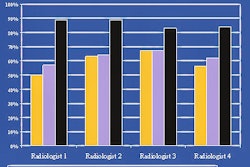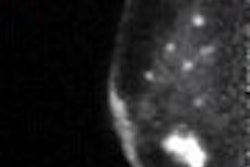Fischer Imaging's decision to sell its mammography intellectual property to rival Hologic will likely mean the end of Fischer's SenoScan full-field digital mammography product, which employed a novel approach to FFDM by using charge-coupled device (CCD) digital technology.
Fischer of Denver surprised industry observers last week when it announced plans to sell its mammography IP to Bedford, MA-based Hologic for $32 million in a deal that effectively ends Fischer's participation in the mammography market. The sale includes SenoScan technology as well as the company's MammoTest stereotactic breast biopsy systems. Hologic has said that while it may use Fischer technology in future products, it has no plans to sell SenoScan or MammoTest under its own branding.
Hologic will acquire Fischer's customer list and customer relationships in addition to its existing technology and product lines. Fischer will relinquish the right to sell SenoScan or MammoTest, with two exceptions: It will continue to sell SenoScan to multimodality vendor Philips Medical Systems of Andover, MA, which has rights to distribute the system worldwide, through October 2007.
Fischer will also continue to sell MammoTest tables through October 2006 to Johnson & Johnson's Ethicon Endo-Surgery division of Cincinnati, which distributes them in Europe, the Middle East, and South Africa. Fischer will not renew these agreements once they have ended. Hologic is not buying Fischer's installed base of either SenoScan or MammoTest units; Fischer will retain a service warranty obligation to existing customers, according to president and CEO Harris Ravine.
"We will continue to support the installed SenoScan and MammoTest base," Ravine said. "We do not plan to abandon our customers."
Buying Fischer's mammography IP offers Hologic a number of benefits, including a broader customer base and therefore access to new customer relationships, little transaction risk, no transition costs or other liabilities, and an opportunity for incremental revenue and profits going forward, according to chairman and CEO Jack Cumming.
"Over the next several years, Hologic will continue to broaden its breast health offerings," he said. "By taking a combination of the best of both (Fischer's and Hologic's) technologies, we believe we'll be able to provide a better platform in the years to come."
A venerable company
Fischer is one of the oldest medical imaging firms in the U.S., founded in 1910 by H.G. Fischer, just nine years after Wilhelm Roentgen received the Nobel Prize for the discovery of the x-ray. The company sold most of its products via OEM partners such as GE, Picker, Xerox, Varian, and others until the 1990s, when it sharpened its focus on women's health products and started to sell under its own name.
SenoScan was cleared by the Food and Drug Administration in September 2001, following close on the heels of GE Healthcare's Senographe 2000D clearance in 2000. Since SenoScan was launched, Fischer has fought to compete in a mammography market dominated by large companies, Ravine said.
Over the past five years, Fischer has struggled financially, battling not only external factors but also internal misbehavior that has damaged its financial profile. In July 2003, Fischer was delisted from the Nasdaq stock exchange for failure to submit annual reports on time. In November of last year, the Securities and Exchange Commission found that Fischer misstated its revenue, inventory, net income, and gross profit in regulatory filings and press releases from the years 2000 to 2002.
And on June 8, the SEC filed a complaint against Fischer accusing former executives -- including former CEO Louis Rivelli -- of improperly boosting revenue by $45 million over 11 quarters from 2001 to 2003; the company's July 2003 restatement erased two years of earnings. The complaint also cites $23 million of equipment that was improperly booked as sales when in fact Fischer still owned it, according to the SEC's report.
In February, Fischer entered into a $10 million loan agreement with ComVest Investment Partners of West Palm Beach, FL, that it planned to use to resolve existing debt and as working capital for operations. By the time Fischer posted its first-quarter results, however, the loan had contributed to a net loss of $6.6 million. Facing liquidity constraints, Fischer took steps to reduce expenses and investigate strategic alternatives, Ravine said.
With Fischer's financial woes mounting, industry watchers might have expected the firm to broker a deal with its partner Philips, which has been selling SenoScan worldwide since 2004. Add to the mix Fischer's and Hologic's awkward history -- in 2002, Fischer won a $32.2 million patent infringement settlement against Thermo Electron and Hologic -- and the fact that Hologic will not continue to manufacture or sell the SenoScan or MammoTest lines, according to executive vice president and CFO Glen Muir, and the deal seems even more unexpected.
Fischer has been one of a minority of companies to use detectors made of CCDs in its full-field digital technology, rather than the amorphous silicon or amorphous selenium detectors that most of its FFDM competitors are using. While CCDs are an older technology, the approach enabled Fischer to tout SenoScan's higher resolution, with 50-micron resolution in normal mode and 25-micron resolution in magnification mode. SenoScan also used a slot-scanning approach that Fischer claims reduces patient radiation dose. There are some 100 SenoScan units installed in the field, according to Muir.
While the deal with Hologic effectively retires the SenoScan and MammoTest product lines, Hologic plans to incorporate some of SenoScan's and MammoTest's features in future products, Muir said in a June 23 conference call. But Fischer's full-field digital technology will not be used with Hologic's amorphous selenium-based FFDM offering, Selenia, Cumming said. Instead, Hologic intends to focus on using Fischer's research on fusing digital breast imaging and biopsy with ultrasound as it continues its R&D on fusing tomosynthesis with ultrasound.
"Fischer has done some interesting things with fusion, particularly fusion of digital breast imaging and ultrasound," Cumming said. "Our concentration has been tomosynthesis, and we want to work to fuse that technology with ultrasound, so we want to use their work in that area."
By Kate Madden Yee
AuntMinnie.com contributing writer
June 30, 2005
Related Reading
Hologic to buy Fischer's mammo technology, June 23, 2005
Fischer names COO, June 3, 2005
Fischer posts mixed Q1, May 23, 2005
Fischer late with 10-Q report, May 17, 2005
Fischer's 2004 net loss narrows on higher sales, April 1, 2005
Copyright © 2005 AuntMinnie.com



















